For an introduction to Conditions on BridgeStation, please see: Condition (BCI) - Introduction
Guidance Document
The following guidance document is the basis for the calculations in BridgeStation
Guidance Document for Performance Measurement of Highway Structures (supersedes Volume 2)
Part B1: Condition Performance Indicator
Report prepared on behalf of: Highways Agency, CSS Bridges Group (2007)
Scale and Rating
Both BCI Average and BCI Critical are defined on a scale of 100 (best possible condition) to 0 (worst possible condition). Rating bands are also used to further simplify the scoring.
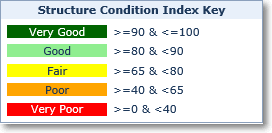
Bridge Condition Index (BCI) Average
The BCI Average considers all the elements in the structure. Note: there are some elements that are not used in condition calculations. More details are provided in the above guidance document.
Multiple elements
If more than one example of the same element is present, both results are still used in the calculation. In the example below the element hierarchy includes two Half Joints.
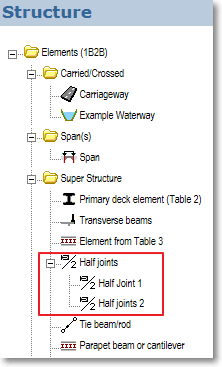
So both can be inspected and their conditions used in the calculation.
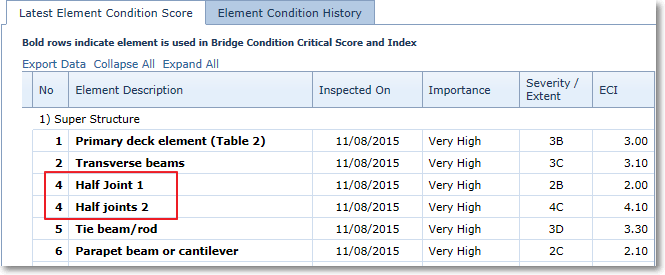
Multiple defects
When it comes to multiple defects collected at inspection time, things are treated slightly differently. Multiple defects are additional conditions applied to the same element. So below we only have one Primary Deck Element, but two defects applied to this element.
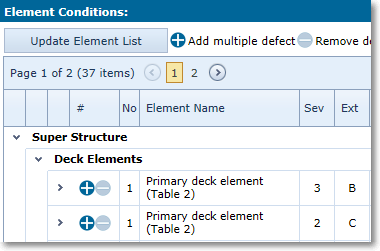
When it comes to the BCI Average then the worst condition for that element is passed through. In the example above, it will be the 3B that is passed to the calculation.

Bridge Condition Index (BCI) Critical
The Critical Index and Rating is based solely upon elements with a Very High Importance factor. If an element description is shown in bold in the table it means that it is one of these 'critical elements'. The Importance factor is also shown as a column in the Latest Element Condition Score table.
The Structure's BCS and BCI Critical is based around the worst of these 'critical elements'. So in the example below, we have a Critical Score of 3.30, which then corresponds to an Index of 50.32
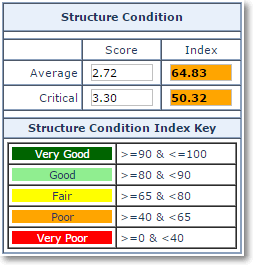
Searching the Latest Element Condition Score table we can see the bold 'critical elements' and the highest (worst) ECI is indeed 3.30.
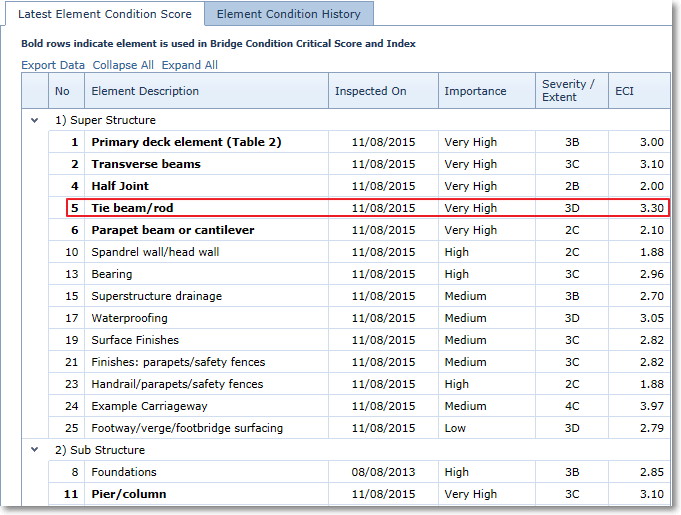
State of Good Repair (SOGR)
A structure is considered to be in a 'State of Good Repair' if the weighted BCI Score (0.6 x BCI Average + 0.4 x BCI Critical) is greater than 65. The state of good repair is used in Structure Stock reporting.
SOGR (% Area)
LoBEG and TfL have sought to simplify the way the condition of individuals and stocks of structures are indicated and reported in all their relevant performance reports, without moving away from the principles of the established Bridge Condition Indicators methodology. It was agreed that a single number (State of Good Repair) would achieve this as a measure of condition. The following formula for the State of Good Repair (SoGR) has been defined:
A structure is considered in a State of Good Repair (SOGR) if its "BCI Combined" is >= 65.
Where, BCI Combined (SOGR Condition) = (0.6 × BCI Average) + (0.4 × BCI Critical)
SOGR (% Area) is then calculated as % of structure stock area (weighted by AVF) in a State of Good Repair (ie BCI Combined >=65).